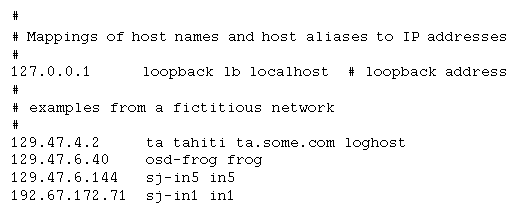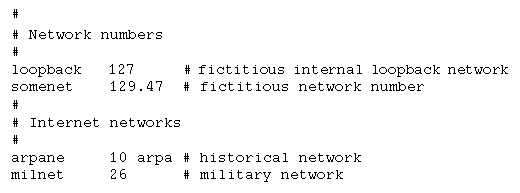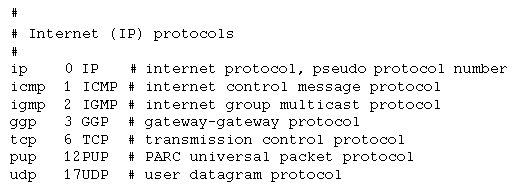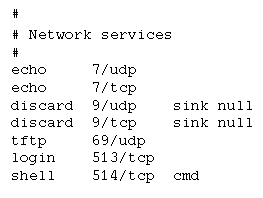Sample HOSTS File

TCP/IP uses four database files in the SYS:\ETC\directory to convert internal data, such as IP addresses, into more identifiable and workable names.
The user interface for TCPCON and other NLM files uses these database files. To inform TCP/IP of names and addresses of local nodes and networks, you must add that information to these files. The files are cached in memory so that disk access is avoided during lookup. Because of this, TCP/IP takes up more memory. If this is not desirable, keep the size of the database small or simply delete the files.
TCP/IP finds the following four database files in the SYS:\ETC\directory:
These files are described in the sections following this discussion.
If you are configuring TCP/IP for the first time, we recommend that you start by copying the sample database files from SYS:\ETC\SAMPLES to SYS:\ETC. This provides you with some examples to refer to as you add your own entries, and also provides TCP/IP with the PROTOCOL and SERVICES files.
You can modify these files with a standard text editor from any NetWare® client, or you can use EDIT.NLM from the NetWare system console. The following sections describe the formats of the files, which are compatible with the same files on standard 4.3BSD UNIX* systems. The examples in the sample files can also help you create your own entries.
The files have the same names and format as the files on UnixWare* systems and other UNIX systems. You can use FTP to transfer the files from a UNIX host.
Each database file describes a table. Each line of the file describes a separate table entry. Blank lines and comments are ignored. Comments begin with a pound sign (#) anywhere in a line and include the pound sign and any characters following it on the same line.
IMPORTANT: Do not use the sample addresses provided in the database files if you are connected to the Internet; these addresses are for example only.
The SYS:\ETC\HOSTS file contains information about the known hosts on the IP internetwork. Typically, it is centrally administered and distributed to all local hosts. Its format, as shown in Figure 15, is identical to /etc/hosts on UNIX systems. Each entry provides information about a single host. An entry cannot extend beyond one line.
Figure 15
Sample HOSTS File
The HOSTS file entry has the following format:
IP_address host_name [alias [...]]
The IP_address is a 4-byte address in standard dotted decimal notation. Each byte is a decimal, hexadecimal, or octal value and is separated by a period. Hexadecimal numbers must start with the character pair 0x or 0X; octal numbers must start with 0.
The host_name is the name of the system associated with this IP address. The name cannot contain a space, tab, pound sign (#), or end-of-line character. Each hostname must be unique.
The alias is another name for the same system. Typically, this is a shorter name. A single host can have from 1 to 10 aliases. For example, the host sales could have the following address and aliases:
129.0.9.5 sales sa saleshost
The sample file SYS:\ETC\SAMPLES\HOSTS is included with the TCP/IP software. When you are configuring TCP/IP for the first time, copy the sample HOSTS file from SYS:\ETC\SAMPLES to SYS:\ETC. You then edit the SYS:\ETC\HOSTS file. You can change your configuration at any time by editing your existing SYS:\ETC\HOSTS file.
The SYS:\ETC\NETWORKS file contains information about the networks in your internetwork. Each entry provides information about one network. An entry cannot extend beyond one line. Figure 16 shows a sample NETWORKS file.
Figure 16
Sample NETWORKS File
The NETWORKS file entry has the following format:
network_name network_number [/network_mask] [alias [...]]
The network_name is the name of the network associated with this network number. The name cannot contain a space, tab, pound sign (#), or end-of-line character. The network name must be unique.
The network_number is the number of the network. Hexadecimal numbers must start with the character pair 0x or 0X. The network_number can be specified with or without trailing zeros. For example, the addresses 130.57 and 130.57.0.0 denote the same IP network.
The network_mask is the subnet mask of the network. Like IP addresses, it can be specified in octal, decimal, or hexadecimal notation. This field is optional. If not specified, the subnet mask is deduced from existing routing table entries.
The alias is another name for the same network; you can specify up to 10 aliases for a network.
The sample file SYS:\ETC\SAMPLES\NETWORKS is included with the TCP/IP software. When you are configuring TCP/IP for the first time, copy the sample NETWORKS file from SYS:\ETC\SAMPLES to SYS:\ETC. Then edit the SYS:\ETC\NETWORKS file. You can change your configuration at any time by editing your existing SYS:\ETC\NETWORKS file.
The SYS:\ETC\PROTOCOL file, as shown in Figure 17, contains information about the known protocols used on the internetwork. Each line provides information about one protocol. An entry cannot extend beyond one line.
NOTE: The PROTOCOL file is called PROTOCOLS on UNIX systems. The name is shortened to PROTOCOL because of the DOS eight-character limit.
Figure 17
Sample PROTOCOL File
The PROTOCOL file entry has the following format:
protocol_name protocol_number [alias [...]]
The protocol_name is the name of the Internet protocol associated with this protocol number. The name cannot contain a space, tab, pound sign (#), or end-of-line character.
The protocol_number is the number of the Internet protocol.
The alias is an alternate name for the protocol.
The sample file SYS:\ETC\SAMPLES\PROTOCOL is included with the TCP/IP software. When you are configuring TCP/IP for the first time, copy the sample PROTOCOL file from SYS:\ETC\SAMPLES to SYS:\ETC. You can then edit the SYS:\ETC\PROTOCOL file. You can change your configuration at any time by editing your existing SYS:\ETC\PROTOCOL file.
The SYS:\ETC\SERVICES file, as shown in Figure 18, contains information about the known services used on the IP internetwork. Each entry provides information about one service. An entry cannot extend beyond one line.
Figure 18
Sample SERVICES File
The SERVICES file entry has the following format:
service_name port_number /protocol_name [alias [...]]
The service_name is the name of the service associated with this port number and protocol name. The name cannot contain a space, tab, pound sign (#), or end-of-line character. These are generally Application-layer, Presentation-layer, or Session-layer services, such as TFTP, FTP, SMTP, and TELNET.
The port_number is the number of the Internet port used by the service.
The protocol_name is the protocol with which the service is associated. This is generally a Transport- or Network-layer protocol, such as TCP or UDP. You must put a slash between the port number and the protocol name (for example, SMTP 25/TCP MAIL).
The alias is an alternate name for the service.
The sample file SYS:\ETC\SAMPLES\SERVICES is included with the TCP/IP software. When you are configuring TCP/IP for the first time, you should copy the sample SERVICES file from SYS:\ETC\SAMPLES to SYS:\ETC. You can then edit the SYS:\ETC\SERVICES file. You can change your configuration at any time by editing your existing SYS:\ETC\SERVICES file.